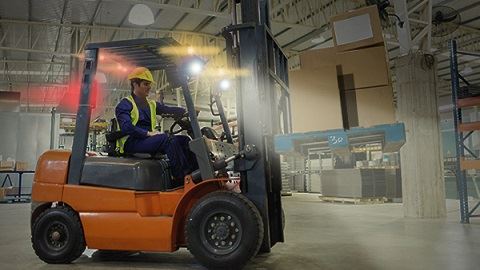Forklift lights are rather easy. You control them by manipulating the controls on each fork and then make adjustments according to your vehicle’s balance, maneuvering it in its orientation. However, when these lights don’t stay working or give off the right signals, you will pay more which means the added cost will have to be paid for by you or your company.
What is a Forklift Light
For many years, forklift lights have been a mainstay on industrial and commercial machines. Forklift lights serve as both warning and guidance devices for the operator. They provide illumination in dark areas so that workers can see where they are going and avoid obstacles. Forklift lights also help to identify and warn other people of danger in the area.
Forklift lights come in a variety of colors and styles, depending on the needs of the operator and the location or workspace in which they are working. Some forklift lights have detachable heads so that they can be attached to different types of equipment. Others include an integrated light system that is permanently mounted on the machine. Many forklift lights are now adjustable to accommodate different heights and widths, making them more versatile in use.
How to Setup a Forklift Light
If you operate a forklift, you need to know how to set the lift height and light. Lift height determines how much of the load the forklift can carry, while the light determines how bright the headlights should be during night operation.
How Many Lights do You Need?
There are a few factors to consider when deciding how many forklift lights you will need. The size of the forklift, the type of light being used, and the environment in which it will be used all play a role.
If you are using a standard residential light, you’ll likely need 1-2 lights. Lights specifically designed for forklifts may have more than 2 bulbs, depending on their output. In general, the brighter the light, the better.
Another consideration is where your forklift is going to be used. Forklift operators should use lights that can see in both directions down the convex path of the forks, as well as in front and behind them. Lights should also be able to see up into the cab so they know if someone is coming from behind them or from above.
What Do I Need to Install the Lights
Installing forklift lights is a simple process that can make your work area safer and more pleasant. Here are the basics you need to know:
- Choose the right light. There are a variety of forklift lights available, so it’s important to select the one that best suits your needs. Some light options include spotlights, floodlights, and strobes.
- Mount the light. To install the light, first, locate the mount on your forklift. Most mounts are located either in the bed or near the load hook. Once you locate the mount, screw in the light’s mounting plate.
- Test the light. Before you put the light in production, it’s important to test it to make sure everything is working properly. To do this, turn on the light and wait a few seconds for it to warm up. Once it has warmed up, shine the light in different directions to make sure it is properly illuminating your work area.
- Finish up by tailoring the light. Forklift lights can be tailored to create a unique look for your work area. This includes adding stickers, painting the light, or installing a light cover.
The forklift operator’s lights are essential for safely performing their job. Understanding the requirements for forklift light installation will ensure that your equipment complies with state and federal regulations.
Frequently Asked Questions That Don’t Fit Into This Outline
When it comes to safety, forklift operators need to know the basics. Here are some frequently asked questions that don’t fit neatly into this outline:
Q: What should I do if I see a worker gets hurt on my forklift?
A: If you or someone else sees an injured worker, stop the forklift and call 911. Keep the person safe until help arrives.
Q: What are the important safety rules for forklift operators?
A: Always wear properly fitted and protective safety gear when operating a forklift, including a collar and appropriate eye protection. Follow all OSHA safety regulations. Always keep your hands and arms clear of moving parts. Never stand in front of or behind the forklift while it is in motion.
Conclusion
As a forklift operator, it’s important to be aware of your surroundings and take the time to learn about potential hazards that could affect you. In this article, I’ll outline some of the main dangers you could encounter on a forklift and how to avoid them. By being prepared, you’ll keep yourself safe while lifting loads and help prevent lower-body injuries in the future.

